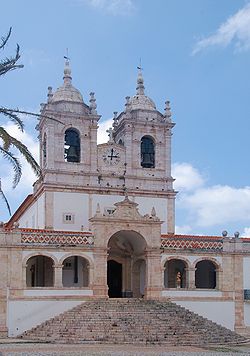
Church of Nossa Senhora da Nazaré
Encyclopedia

Portugal
Portugal , officially the Portuguese Republic is a country situated in southwestern Europe on the Iberian Peninsula. Portugal is the westernmost country of Europe, and is bordered by the Atlantic Ocean to the West and South and by Spain to the North and East. The Atlantic archipelagos of the...
.
According to the Legend of Nazaré the sheriff
Sheriff
A sheriff is in principle a legal official with responsibility for a county. In practice, the specific combination of legal, political, and ceremonial duties of a sheriff varies greatly from country to country....
(alcaide) of Porto de Mós
Porto de Mós
Porto de Mós is a town in Porto de Mós Municipality in Portugal....
, Dom Fuas Roupinho, maybe a templar, was chasing on horseback a deer up a hilltop on a misty September morning in 1182 (later it was said that it was the devil, in the disguise of a deer). When the deer jumped over the edge of the hilltop into the void, his fiery horse was about to follow. Then the knight invoked the intervention of the Madonna, who made the horse turn away through a supernatural effort and saved the life of the knight. Subsequently, a chapel A Ermida da Memoria, was built very near this spot, over a grotto where stood a small statue of a Black Madonna
Black Madonna
A Black Madonna or Black Virgin is a statue or painting of the Virgin Mary in which the Virgin Mary is black. The term was especially applied to those created in Europe in the medieval period or earlier...
, brought from Nazareth
Nazareth
Nazareth is the largest city in the North District of Israel. Known as "the Arab capital of Israel," the population is made up predominantly of Palestinian Arab citizens of Israel...
, [modern [Israel; then southern Syria]]. Near the chapel one can see the imprint of the horseshoe in the rock.
The church, founded in 14th century, was rebuilt in the 17th, 18th and 19th centuries. Semicircular steps lead to a Baroque
Baroque architecture
Baroque architecture is a term used to describe the building style of the Baroque era, begun in late sixteenth century Italy, that took the Roman vocabulary of Renaissance architecture and used it in a new rhetorical and theatrical fashion, often to express the triumph of the Catholic Church and...
portal under two square belltowers. The façade has gallery-like extensions.
The profusely decorated gilded apse
Apse
In architecture, the apse is a semicircular recess covered with a hemispherical vault or semi-dome...
shows the small statue of Nossa Senhora da Nazaré in a lit niche above the main altar, flanked by twisted columns. Above the crossing of the single nave
Nave
In Romanesque and Gothic Christian abbey, cathedral basilica and church architecture, the nave is the central approach to the high altar, the main body of the church. "Nave" was probably suggested by the keel shape of its vaulting...
with the transept
Transept
For the periodical go to The Transept.A transept is a transverse section, of any building, which lies across the main body of the building. In Christian churches, a transept is an area set crosswise to the nave in a cruciform building in Romanesque and Gothic Christian church architecture...
is a cupola
Cupola
In architecture, a cupola is a small, most-often dome-like, structure on top of a building. Often used to provide a lookout or to admit light and air, it usually crowns a larger roof or dome....
and a lantern
Lantern
A lantern is a portable lighting device or mounted light fixture used to illuminate broad areas. Lanterns may also be used for signaling, as 'torches', or as general light sources outdoors . Low light level varieties are used for decoration. The term "lantern" is also used more generically to...
. They are all vaulted by a gilt coffer ceiling
Coffer
A coffer in architecture, is a sunken panel in the shape of a square, rectangle, or octagon in a ceiling, soffit or vault...
.
The many azulejo
Azulejo
Azulejo from the Arabic word Zellige زليج is a form of Portuguese or Spanish painted, tin-glazed, ceramic tilework. They have become a typical aspect of Portuguese culture, having been produced without interruption for five centuries...
s in the transept were made in 1708 by the Dutch ceramist Willem van der Kloet(1666–1747). They depict biblical scenes, among them Joseph
Joseph (Hebrew Bible)
Joseph is an important character in the Hebrew bible, where he connects the story of Abraham, Isaac and Jacob in Canaan to the subsequent story of the liberation of the Israelites from slavery in Egypt....
being sold as a slave by his brothers.
On 8 September of each year a romaria (religious festival) draws many tourists and pilgrims with the processions, bullfights and folk dancing.

